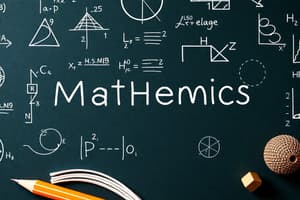Podcast
Questions and Answers
Which symbol represents the mathematical operation of division?
Which symbol represents the mathematical operation of division?
- +
- *
- / (correct)
- √
In which field is mathematics MOST often used for designing, analyzing, and optimizing systems?
In which field is mathematics MOST often used for designing, analyzing, and optimizing systems?
- History
- Literature
- Engineering (correct)
- Culinary Arts
What is the first step in a general problem-solving strategy?
What is the first step in a general problem-solving strategy?
- Implement the plan
- Analyze the problem
- Evaluate the solution
- Identify the problem (correct)
Which mathematical concept indicates the repeated multiplication of a number by itself?
Which mathematical concept indicates the repeated multiplication of a number by itself?
Which field utilizes mathematical tools for calculating interest rates and analyzing market trends?
Which field utilizes mathematical tools for calculating interest rates and analyzing market trends?
Which branch of mathematics is primarily concerned with the properties and relationships of integers?
Which branch of mathematics is primarily concerned with the properties and relationships of integers?
What is the purpose of a mathematical proof?
What is the purpose of a mathematical proof?
In mathematics, what term describes a statement that is accepted as true without requiring a proof?
In mathematics, what term describes a statement that is accepted as true without requiring a proof?
Which of the following branches of mathematics deals with the analysis of continuous change?
Which of the following branches of mathematics deals with the analysis of continuous change?
What is the primary focus of the mathematical field of geometry?
What is the primary focus of the mathematical field of geometry?
What does the term 'variable' represent in mathematics?
What does the term 'variable' represent in mathematics?
Which operation is symbolized by the '+' sign?
Which operation is symbolized by the '+' sign?
Which of the following statements is true of a 'function' in mathematics?
Which of the following statements is true of a 'function' in mathematics?
Flashcards
Division
Division
Separating a quantity into equal parts, symbolized by '/' or '÷'.
Exponents
Exponents
Repeated multiplication of a number by itself, symbolized by '^'.
Identify the problem
Identify the problem
Clearly define what needs to be solved in a mathematical context.
Analyze the problem
Analyze the problem
Signup and view all the flashcards
Mathematical notation
Mathematical notation
Signup and view all the flashcards
Mathematics
Mathematics
Signup and view all the flashcards
Algebra
Algebra
Signup and view all the flashcards
Geometry
Geometry
Signup and view all the flashcards
Calculus
Calculus
Signup and view all the flashcards
Functions
Functions
Signup and view all the flashcards
Variables
Variables
Signup and view all the flashcards
Proofs
Proofs
Signup and view all the flashcards
Addition
Addition
Signup and view all the flashcards
Study Notes
Introduction to Mathematics
- Mathematics is a fundamental field of study that deals with abstract concepts like quantity, structure, space, and change
- It uses logic and reasoning to formulate and solve problems across diverse fields like physics, computer science, and engineering.
Branches of Mathematics
- Arithmetic: The study of numbers, including operations like addition, subtraction, multiplication, and division
- Algebra: Deals with symbols and their manipulation to express relationships and solve equations
- Geometry: Focuses on shapes, sizes, and properties of space, including points, lines, curves, and surfaces
- Calculus: Studies continuous change and its rates, including limits, derivatives, and integrals of functions
- Number Theory: Investigates the properties of integers and their relationships
- Statistics: Explores data collection, analysis, interpretation, and presentation of numerical data.
- Probability: Analyzes the likelihood of events occurring and their outcomes
- Trigonometry: Studies the relationships between the sides and angles of triangles
- Discrete Mathematics: Focuses on countable or discrete objects and structures
Key Concepts in Mathematics
- Sets: A collection of distinct objects. Sets can contain numbers, letters, or even other sets.
- Functions: A relationship between inputs (domain) and outputs (range). Each input corresponds to one output.
- Equations: Statements of equality between expressions. Solving equations involves finding values that satisfy the equality.
- Variables: Symbols that represent unknown or changing quantities. These are often used in equations and formulas.
- Proofs: Logical arguments that demonstrate the truth of a mathematical statement. Rigorous proofs are fundamental to mathematical validity.
- Theorems: Statements that have been proven to be true through mathematical reasoning.
- Postulates/Axioms: Basic statements assumed to be true without proof; fundamental building blocks of mathematical systems.
- Numbers: Various types of numbers exist, including natural numbers, integers, rational numbers, irrational numbers, and real numbers
Fundamental Operations
- Addition: Combining two or more quantities; symbolized by '+'.
- Subtraction: Finding the difference between two quantities; symbolized by '-'.
- Multiplication: Combining equal quantities; symbolized by '*' or '×'.
- Division: Separating a quantity into equal parts; symbolized by '/' or '÷'.
- Exponents: Repeated multiplication of a number by itself; symbolized by '^'.
Applications of Mathematics
- Science: Models and simulations in physics, chemistry, and biology often rely heavily on mathematical analysis.
- Engineering: Design, analysis, and optimization of structures and systems involve complex mathematical calculations.
- Computer Science: Algorithms, data structures, and cryptography often rely on mathematical foundations.
- Finance: Calculating interest rates, analyzing market trends, and modeling financial instruments, requiring mathematical tools.
Problem Solving Strategies
- Identify the problem: Clearly define what needs to be solved.
- Gather information: Gather all relevant data and information.
- Analyze the problem: Break down the problem into smaller, manageable parts; identify patterns and relationships.
- Develop a plan: Outline a step-by-step solution, potentially using equations or formulas.
- Implement the plan: Follow the outlined steps and perform the necessary calculations.
- Evaluate the solution: Verify the answer and assess its validity.
- Communicate the solution: Present the results and reasoning clearly.
Mathematical Notation
- Symbols: Various symbols represent different mathematical concepts (e.g., '=', '+', '-', '*', '/', '√', '∑').
- Formatting: Precise formatting is crucial for clarity, particularly in expressions involving multiple terms or steps.
Areas for Further Exploration
- Specific branches of mathematics (e.g., number theory, topology)
- Historical developments in mathematical thought
- Modern applications of mathematics in various fields
- Mathematical proofs and their structure
- Mathematical software and tools
Studying That Suits You
Use AI to generate personalized quizzes and flashcards to suit your learning preferences.




